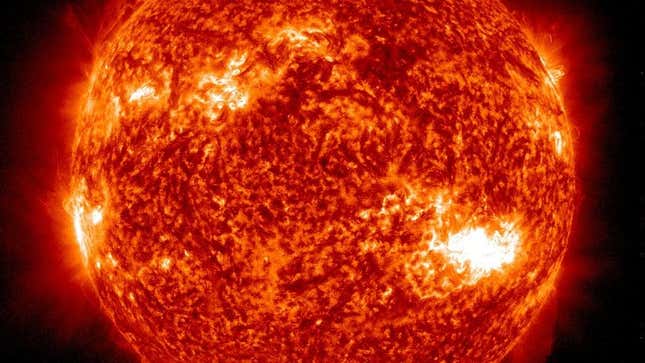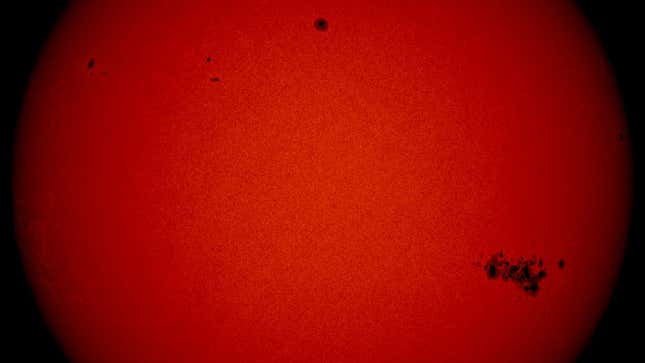
Inclement weather on the Sun’s surface could affect infrastructure on Earth and in space, scientists are predicting, as our host star approaches its solar maximum.
NOAA’s Space Weather Prediction Center issued a severe (G4) geomagnetic storm watch this week, the first since January 2005. Five Earth-directed coronal mass ejections (CMEs) have so far been observed and are expected to arrive on our planet today and over the weekend. Several strong solar flares were observed and associated with a large sunspot on the Sun’s surface, about 16 times as wide as Earth.
The Sun’s solar cycle is an 11-year period in which the star’s magnetic field flips back and forth; this flipping causes sunspots on the star’s surface, where its magnetic field lines are particularly strong, making them venues for dynamic, violent solar events like flares and CMEs. These events spew particles that, when directed at Earth, can disrupt radio communication, the power grid, and cause beautiful aurora as the particles interact with Earth’s atmosphere.

The oversized sunspot is “perhaps the most complex we’ve seen this cycle,” but the storm activity from it is “nothing that can’t be handled, as far as we understand it,” according Shawn Dahl, a space weather forecaster at SWPC, who spoke in a press conference today. “The key point here is that critical infrastructure operators have been notified and that the activity is not over.”
There have been three G4 events since 2019, the most recent being in March 2024. But even that event was on the low-end of the G4 scale, and Dahl said that, while the team doesn’t expect as extreme an event as the 1859 Carrington Event (a G5-level storm), this weekend’s storm could sneak into the lower end of the G5 categorization. “We have a very rare event on our hands,” Dahl said.
Space-based observatories at L1—a point about one million miles from Earth—will monitor the initial arrival of particles from the Sun as they head towards our planet at about 1.8 million miles per hour (2.9 million kilometers per hour). Once the information is verified by agencies like NOAA’s Space Weather Prediction Center, scientists and forecasters will have between 20 and 45 minutes to advise operators of critical infrastructure on how to best prepare for the particles’ arrival.
Brent Gordon, Chief of the Space Weather Services Branch at the Space Weather Prediction Center, said in the press conference that the team has been seeing new CMEs from the sunspot every six to 12 hours, with the most recent occurring around 3 a.m. ET.
The team expressed uncertainty about the severity of impacts on Earth depending on the orientation of the CMEs to the Earth, as well as whether multiple shocks will occur or just a singular event as the ejections depart the Sun. However, Gordon said that multiple shocks over the course of the weekend are possible.
Auroras may be visible as far south as northern Alabama, Dahl said, but don’t be dismayed if you’re even further south. “With new technology in our phones, we’re been seeing some amazing aurora shots even further south,” Gordon said. “Even things the human eye can’t see, your phone can.”
As far as what the public can do to prepare? Not much outside of what you would normally do to prepare for a power outage. If the storm affects critical electrical infrastructure it will impact high-voltage transmission lines, so not to worry about your home’s personal transformer. Just make sure—as you should for any emergency!—that you have the standards in emergency equipment, like a flashlight or a backup generator.
More: NASA Probe’s Daring Flight Through Sun’s Eruption Sheds Light on Solar Storms